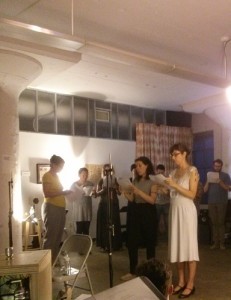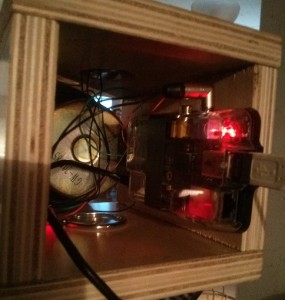Dogstar 10: Experimental Music Concert Series in Los Angeles
 The annual Dogstar Orchestra concert series of experimental music has been going in various locations in and around Los Angeles since May 30. The venue on June 10 was the Wulf, a converted industrial loft space on Santa Fe street downtown, and a good-sized crowd settled in for an evening of spoken and electronic works. The concert was curated by Sara Roberts and Clay Chaplin.
The annual Dogstar Orchestra concert series of experimental music has been going in various locations in and around Los Angeles since May 30. The venue on June 10 was the Wulf, a converted industrial loft space on Santa Fe street downtown, and a good-sized crowd settled in for an evening of spoken and electronic works. The concert was curated by Sara Roberts and Clay Chaplin.
The concert opened with Black & White Oratorio by Robert Lax. A chorus of 15 voices and three soloists performed this piece which consists of groups of words for color that are spoken in various patterns and sequences. A soloist starts the piece with a series of phrases such as “Black, Black, Black, Black, Black, Black, White.” At length the chorus joined in with a series of similar phrases, but with variations in the Black/White sequence. The speaking has a pulse that allows the chorus to speak in unison, in divisi, or to pause for several beats together. The written score runs to 54 pages and the words are grouped in a series of columns on the page that represent the pulses, with each row of words forming the spoken phrase. This performance of Black & White Oratorio extended for almost 40 minutes but never lost the attention of those listening.
At times the words were spoken in unison, at other times the soloists would speak – always with the same chant-like pulse – but often introducing new colors into the sequences. The combinations would repeat often enough to establish a pattern, and this would be broken by the soloists or with a new sequence of words in the chorus. The pronunciation of the various color words in different combinations often accentuated the sense of rhythm. Repeating “Black White” in the chorus, for example, produced a march-like cadence. When a color word had a single syllable, like Red, there was a strong sound. A word like Orange, with two syllables and a softer sound at the end, added a sort of counterpoint to the pattern of pulses. When the soloists were speaking in sequences of “Red, Blue” with the chorus speaking “Black, White”, a definite sense of tension developed. Some sequences felt light and almost melodic while others resembled more the pattern of a steady drumming. At one point there was even a grand pause that lasted for several silent pulses.
The patterns and motifs that emerge as this piece progresses are always engaging and reveal how musical a work can sound without resorting to pitch or harmony. As the program notes explain: “Rehearsing these color poems has been an incantatory and abstractly hallucinogenic experience.” There were just two full rehearsals for this performance and the recitation went very well with only a few inevitable miscues, but these did not affect the flow of the piece.
Robert Lax (1915 – 2000) has been described as an abstract minimalist poet, and Black & White Oratorio certainly fits into that category. Lax was born in Olean, NY and attended Columbia University. He wrote for several magazines, including the New Yorker, and he was a friend of Thomas Merton. Lax lived on the Isle of Patmos in Greece for the last 35 years of his life and this is where Black & White Oratorio was written. This piece seems to exist in that space between music and poetry and even without tone or pitch, the words, the sequences and the rhythms seem to be transmitting musical content within its private vocabulary. The soloists for this performance were Jen Hutton, Heather Lockie and Morgan Gerstmar and the director was Sara Roberts.
After a short intermission the concert continued with Three Pieces for Networked Speakers. Seven small speakers were set up in a circular pattern around the performance space and each was fitted with a Raspberry Pi micro-computer and amplifier. The micro-computers were networked together and this allowed the electronic works to be processed in real time.
Type A Nightmare No. 2 by Clay Chaplin was the first piece and this started out with the electronic singing of an Icelandic folk song fragment. According to the program notes “Type A Nightmare No. 2 is a sound mass piece that uses the inherent latency of the networked speaker system by gradually displacing the playback timing of a sound sample that plays from each speaker.” Over the course of the work the result is that the repeated fragment slowly dissembles into a sonic oblivion and then returns back again.
The starting melody had a solemn, almost sad feel to it that was enhanced as the processing continued. Soon the words became lost in a warm humming drone, producing a distinctly transcendent feel. Eventually white noise crept in, and the sound morphed into something like the humming of bees. This seemed to be coming from different directions at different times, no doubt the result of electronic manipulation of the speaker array. At the mid-point the process reversed and the sound slowly gained a sense of organization and momentum. The humming acquired an organic texture and it seemed to circle around the speakers. Eventually the original melody became recognizable and the piece concluded as it had begun.
The next piece was Synopsis by Sepand Shahab and this began with a low hum that slowly increased in amplitude, then faded away. A second, slightly lower tone was added and zero-beating was clearly heard and this produced a distant, alien feel. A low rumble appeared, like a motorcar roaring in the distance, adding motion to the sense of distance. The upper registers held a soft rolling, clanking and grinding sound that gave off a distinct feeling of unease that increased as the low motor-like rumble faded away. As the piece progressed a low, jet-like roar appeared with two sine waves, close in pitch, that produced more zero-beating. Synopsis came to a satisfactory conclusion as the clanking and rumbling faded away leaving just a clean sine wave that died out at the finish.
The concert concluded with A Glimpse by David Paha and this piece called for six musicians to be stationed at music stands near the speakers, each with a keyboard connected to the Raspberry Pi computer. A Glimpse opened with a single tone that slowly increased in volume, and this was soon joined by others, close in pitch, that produced a variety of zero beating effects. There was a warm, bubbly feeling to this as each player slowly manipulated their pitches in and around the starting tone. The overall effect was like being in a chanting crowd. The piece proceeded in this fashion, with each player following the lead tone, pushing slightly higher or slightly lower to form changing zero-beat patterns and interactions. Towards the conclusion the tones seemed to decay in pitch and volume, giving a feeling of slow devolution and a winding down as the last sound trailed off into silence.
A Glimpse seems to be fashioned from pure sine tones and is reminiscent of the work David Seidel has done in this area. The Raspberry Pi computers and six separate musicians add greatly to the possibilities inherent in this approach, and all of the works in Three Pieces for Networked Speakers provided an interesting insight into the future of electronic music that allows for sound manipulation and processing in real-time.
The Dogstar 10 concerts continue through June 14.
